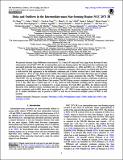Por favor, use este identificador para citar o enlazar a este item:
http://hdl.handle.net/10261/286103COMPARTIR / EXPORTAR:
 SHARE SHARE
 CORE
BASE CORE
BASE
|
|
| Visualizar otros formatos: MARC | Dublin Core | RDF | ORE | MODS | METS | DIDL | DATACITE | |

| Título: | Disks and Outflows in the Intermediate-mass Star-forming Region NGC 2071 IR |
Autor: | Cheng, Yu; Tobin, John J.; Yang, Yao-Lun; van't Hoff, Merel L. R.; Sadavoy, Sarah I.; Osorio, Mayra CSIC ORCID ; Díaz-Rodríguez, Ana Karla; Anglada-Escudé, Guillem CSIC ORCID; Karnath, Nicole; Sheehan, Patrick D.; Li, Zhi-Yun; Reynolds, Nickalas; Murillo, Nadia M.; Zhang, Yichen; Megeath, S. Thomas; Tychoniec, Łukasz | Fecha de publicación: | 13-jul-2022 | Editor: | IOP Publishing | Citación: | Astrophysical Journal 933(2): 178 (2022) | Resumen: | We present Atacama Large Millimeter Array band 6/7 (1.3 mm/0.87 mm) and Very Large Array Ka-band (9 mm) observations toward NGC 2071 IR, an intermediate-mass star-forming region. We characterize the continuum and associated molecular line emission toward the most luminous protostars, i.e., IRS1 and IRS3, on ∼100 au (0farcs2) scales. IRS1 is partly resolved in the millimeter and centimeter continuum, which shows a potential disk. IRS3 has a well-resolved disk appearance in the millimeter continuum and is further resolved into a close binary system separated by ∼40 au at 9 mm. Both sources exhibit clear velocity gradients across their disk major axes in multiple spectral lines including C18O, H2CO, SO, SO2, and complex organic molecules like CH3OH, 13CH3OH, and CH3OCHO. We use an analytic method to fit the Keplerian rotation of the disks and give constraints on physical parameters with a Markov Chain Monte Carlo routine. The IRS3 binary system is estimated to have a total mass of 1.4–1.5 M⊙. IRS1 has a central mass of 3–5 M⊙ based on both kinematic modeling and its spectral energy distribution, assuming that it is dominated by a single protostar. For both IRS1 and IRS3, the inferred ejection directions from different tracers, including radio jet, water maser, molecular outflow, and H2 emission, are not always consistent, and for IRS1 these can be misaligned by ∼50°. IRS3 is better explained by a single precessing jet. A similar mechanism may be present in IRS1 as well but an unresolved multiple system in IRS1 is also possible. © 2022. The Author(s). Published by the American Astronomical Society. | Descripción: | This is an Open Access article distributed under the terms of the Creative Commons Attribution License (http://creativecommons.org/licenses/by/4.0/), which permits unrestricted reuse, distribution, and reproduction in any medium, provided the original work is properly cited. | Versión del editor: | http://dx.doi.org/10.3847/1538-4357/ac7464 | URI: | http://hdl.handle.net/10261/286103 | DOI: | 10.3847/1538-4357/ac7464 | ISSN: | 0004-637X | E-ISSN: | 1538-4357 |
| Aparece en las colecciones: | (IAA) Artículos |
Ficheros en este ítem:
| Fichero | Descripción | Tamaño | Formato | |
|---|---|---|---|---|
| 2022ApJ...933..178C.pdf | 7,03 MB | Adobe PDF |  Visualizar/Abrir |
CORE Recommender
SCOPUSTM
Citations
3
checked on 20-abr-2024
WEB OF SCIENCETM
Citations
2
checked on 24-feb-2024
Page view(s)
34
checked on 23-abr-2024
Download(s)
22
checked on 23-abr-2024
Google ScholarTM
Check
Altmetric
Altmetric
Este item está licenciado bajo una Licencia Creative Commons

